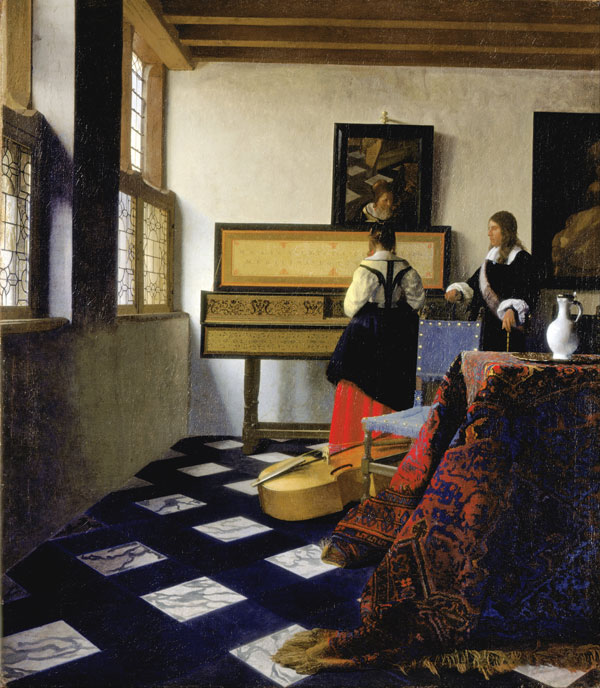
Eye of the Beholder: Johannes Vermeer, Antoni van Leeuwenhoek, and the Reinvention of Seeing, by Laura J. Snyder, Norton, 416 pp., $27.95
On September 17, 1683, the Dutch biologist Antoni van Leeuwenhoek wrote one of the most scientifically important, and completely revolting, letters that London’s Royal Society ever received. He informed his colleagues that he had scraped from between his teeth “a little white matter, which is as thick as if ’twere batter,” and had observed it with a microscope. “In the said matter there were many very little living animalcules, very prettily a-moving.” These tiny creatures were the first observed bacteria, and their discovery revealed a world-within-a-world every bit as marvelous as revelations about the heavens.
The twin subjects of Laura J. Snyder’s new book are Leeuwenhoek and his equally astonishing contemporary, the painter Johannes Vermeer. Born on almost the same day in 1632, they worked most of their lives on the same acre of Delft, then a prosperous city at the height of the Dutch Golden Age. Leeuwenhoek even became the executor of Vermeer’s estate soon after the artist’s death in 1675. The two men’s proximity has long tantalized historians of art and science who have sought to link them as friends, collaborators, and co-conspirators. Snyder, too, suggests a connection, but in the end, the evidence linking them is circumstantial, and as she admits, the theory of their acquaintance ultimately speculative.
Snyder’s attempt to intertwine their lives is nonetheless a rich and rewarding summary of what we know and continue to learn, particularly about Vermeer. Vermeer’s total output numbered in the low dozens of canvases, and fewer than 40 survive. (The authenticity of some is doubtful, but one of the verified masterpieces, The Concert [1664], was stolen in Boston on the night of St. Patrick’s Day 1990. It remains unrecovered.) In these few extant works, Vermeer fanatics see subtleties far deeper than the placid scenes and portraits could be expected to reveal. In the middle and mature works, for example, we see men and women caught in quiet moments of work, concentration, or realization. Vermeer somehow captures whole personalities and lives with textured economy; even Alice Munro or Raymond Carver could conjure such character only in many thousands of words. Aldous Huxley wrote that mescaline revealed delicate beauty in the quotidian objects and experiences all around him. “The nearest approach,” he wrote in The Doors of Perception, “would be a Vermeer.”
Leeuwenhoek’s work was neither delicate nor beautiful. (Snyder says he avidly collected and scrutinized “his own blood, urine, feces, tooth plaque, pus from wounds, the gunk between his toes,” and for good measure, “the wax from ladies’ ears, and lots and lots of semen.”) What connects him to his more refined neighbor, Snyder argues, is their shared interest in the rapidly advancing science of optics. Leeuwenhoek never divulged the mechanism for his microscopes—to this day it remains unclear how he produced them—but he managed to magnify his treasures by hundreds of times and would have hunted down all available knowledge about light. He corresponded with scientists overseas, enclosing affidavits from local grandees testifying to his demonstrations in order to avoid sharing the precise workings of his instruments.
More uncertain, but still convincing, is Vermeer’s relationship to the same body of knowledge. Philip Steadman’s 2001 book Vermeer’s Camera laid out the case that Vermeer would place the well-lit subject of a painting before a camera obscura—a lightproof box with a pinhole that projects an inverted two-dimensional image on the inside—to improve the fidelity, perspective, and proportion of his paintings. The painter David Hockney and physicist Charles Falco have supported this hypothesis. Use of a camera obscura might help explain, for example, Vermeer’s use of depth of field: the subjects of his paintings are in focus, and the background is often not, just as one might expect from a camera. In 2013, the film Tim’s Vermeer followed Vermeer-lover Tim Jenison’s attempt to replicate The Music Lesson (1662–1665), using a slightly different optical technique. He concluded that the evidence fit the hypothesis that Vermeer achieved his effects through such techniques.
Certain Vermeer romantics (including me: the stolen Vermeer is the only one I haven’t made a pilgrimage to worship in person) will read about these mechanisms and scoff instinctively at the idea that a system of boxes, chalk, mirrors, and pins could explain the effect of the greatest of the paintings. Snyder quotes Walter Liedtke, the renowned Metropolitan Museum of Art curator whose death in a train crash in February shocked the Vermeer world, as doubting that Vermeer “sat in a dark closet … and simply ‘copied reality.’ ” Snyder almost certainly shares this opinion. Her appreciation for the art and science is too deep for it to be otherwise. One of the pleasures of her book is that it demonstrates how Vermeer and Leeuwenhoek, rather than copying reality, showed that it contained within it more than one could have supposed—inner space, both psychological and biological. To see the world in a milkmaid’s averted gaze, or in a splash of pond scum, takes genius of a high order, and it is difficult to imagine that two such geniuses could live at the same time, in the same place, only by coincidence.

